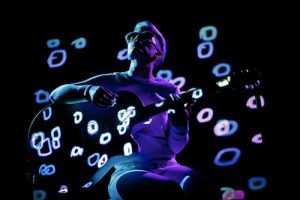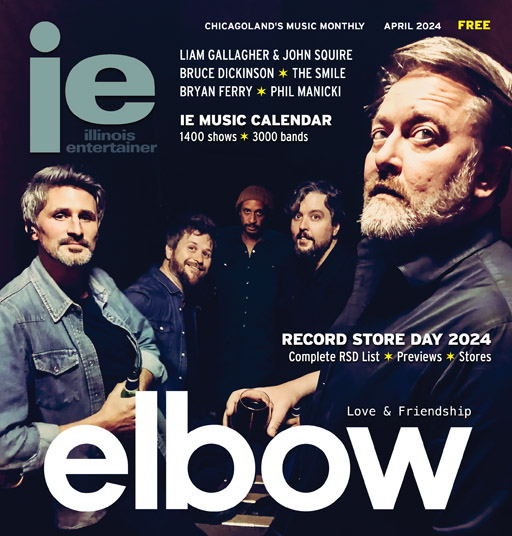File: Hello, My Name is Kaki
Kaki King’s multimedia show The Neck is a Bridge to the Body made its Chicago debut at Lincoln Hall in 2015. The senses-saturating fusion of sight and sound has evolved since then, while the guitarist and her music have done the same. King promises new material in 2018 including the album Live at Berklee, so Tuesday’s performance at City Winery may be a final opportunity for local fans to experience her performance of The Neck. The innovative show explores creation, identity, and impermanence through a combination of thrilling music and dazzling, psychedelic light. During the concert, King assumes a supporting role as her painted Ovation guitar becomes the leading character. King spoke with Illinois Entertainer during a brief stop at home between tour dates.
IE: What do you remember about first bringing The Neck is a Bridge to the Body to Chicago? What has changed since then?
David Bowie had just died when we presented The Neck at City Winery – I remember we did a tribute to him as an encore, and I could barely make it through “Heroes” without crying. I had just hired a new video engineer named Max Bernstein. He has helped make tremendous upgrades to the look and flow of the show since we started working together. I’m definitely more of a character onstage at this point than I was at first. Because of that, I’ve been able to experiment with and change the live guitar music. All in all, I’d say it’s much more in the moment and a more vibrant show.
IE: Experimenting with a complex show like this one can be thrilling or terrifying for a performer. How do you approach that?
There are probably new elements that I’m not consciously aware of every night because with each performance I try something new. If what I try really works beautifully, then I’ll end up doing it again and again. The most challenging element has been the development of my onstage character and how I interact with the audience. I’m barely lit, I don’t speak, and I’m wearing sunglasses, so there’s not a lot to work with. However, I’d also say that creating that character through subtle body language has been the most satisfying. I’m able to appear confident, shy, engaged, or even fearful of the audience, and that has been such an unexpected joy to be able to play around with.
IE: During its run, has the show experienced any fiery disasters or beautiful accidents that make for good storytelling?
Despite running on two laptops that were purchased in 2013, we haven’t had any completely crazy train wrecks thus far. I just ran around my house knocking on wood, FYI.
One time the airline lost my guitar, and I did have to buy a new one, paint it white, drill holes in it, etc. and get it ready for showtime in just a few hours. The guitar was still just a little sticky when I hit the stage, but I look at that story as such a total triumph.
Also, if you want a good story – that experience happened in L.A., and initially I called Guitar Center to see if they stocked Ovations. They had two used ones and described them to me, and one was perfect. I said I would be on my way to buy it when the male employee on the other end of the line said, “Oh, sweetheart, we can’t sell them to you yet. We just bought them, and they have to wait on our wall for 30 days to make sure they aren’t stolen.” SWEETHEART. I asked to speak to a manager, then he said, “Well, we have some other nice guitars here, sweetie, you can get a Takamine.” SWEETIE. CLICK.
IE: Good grief.
I went to the Sam Ash across the street and bought the guitar I needed. After the show onstage that night, I told the entire story, including the Guitar Center drama. It turned out that someone who worked at Guitar Center headquarters was in the audience, and he was embarrassed beyond belief. He said that this would be addressed, and that company-wide employee training would have to change. So, there’s my tiny contribution to #Time’sUp.
IE: What new songs have you incorporated into the show?
I’ve been playing a beautiful song called “Bowen Island” during the encore. We set it to footage of hot air balloons that we rode in Turkey while playing there a few years ago. I think it’s sad and befitting of the time, because Turkey is one of the most enchanting countries I’ve ever been to, and as a US citizen I’m currently not allowed there anymore. I also use a custom bridge I developed with my luthier friend Rachel Rosenkrantz called a Passerelle, which turns the guitar into a koto-like sound. We started producing them, and I sell them at the merch table!
IE: You talked about your character that has emerged. Does that allow you to interact more with the audience?
The intention was always for me to recede and let the focus rest on the guitar, but I’ve found that playing into this character enhances the relationship I have with the guitar even more. Most of the time, the character is curious as to why the audience is even clapping in the first place.
IE: Will The Neck is a Bridge to the Body continue or will it be superseded by whatever you do next?
I would love for The Neck to be archived and suspended in time, to be resurrected years from now when the tech of the day makes it look quaint and simplistic. It’s a very simple and frankly affordable show to produce and perform, so it may yet have life in it for years to come.
IE: Have you already created what comes after this show?
Not yet, but that is the plan for 2018!
IE: Does Live at Berklee feature new compositions, or is it focused on reimagining your earlier music?
There is one entirely new composition on the record. Everything else is older songs that were re-orchestrated by a variety of people, including myself.
IE: What was most satisfying about rearranging your songs with the ensemble?
I think the beauty of revisiting older material with fresh ears, ideally not all my ears, is that so much can be discovered within it that I would never have heard. Some of the orchestrations really went in a fascinating direction.
IE: What was it like to work with the classically-trained Berklee musicians?
Working with the conductor, Gabriela Sofia Gomez Estevez, was such a thrill. The process was very intimidating at first because I had to relearn some of the guitar parts – which were challenging when I wrote them originally. Then I had to be able to play them perfectly each time exactly as they were recorded, while Gabriela conducted me and the other musicians. It’s definitely not something that I was used to, but it was an incredible learning experience.
IE: Is your signature Ovation Adamas guitar still in production? Have you made any refinements to your own, or is it still the ideal?
It is still in production since circa 2008, I believe. I haven’t made any refinements for a while – it’s still exactly what I want.
IE: Who or what inspires you to continue developing as a player and creating music?
I have two small children right now. I listen to Disney soundtracks and Taylor Swift. I’m a shell of my former self. Don’t judge.
– Jeff Elbel
Kaki King performs at City Winery on Tues., Mar. 13.
Tickets: http://bit.ly/2FZvqB8
Category: File










